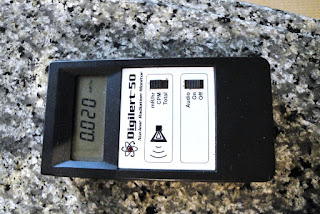 |
| 6 CPM on Kohala Beach, Hawaii Island |
We
continuously monitor radiation levels on Hawaii Island to assure ourselves that
contamination from Fukushima is not washing up on the stretches of beach we
walk every day. Our readings are consistently low on Kohala Coast
beaches. We have put our detector next to any debris that we have found washed
up on the beach and never had a high reading, so far.
The
readings inside our condo on
the Kohala Coast, are often double
the readings we get on the beach, sometimes spiking up to three time
higher. We
have heard that many people are concerned about the possibility of radiation exposure
from past military exercises.
The
U.S. Army conducted training exercises at the Pohakuloa Training Area (PTA) in
the saddle between Mauna Kea and Mauna Loa during the mid-1960's using the M101
“spotting rounds” for the Davy Crockett recoilless gun. According to an Army
report, each round contained approximately one half pound of a uranium alloy
(92% depleted uranium [DU] and 8% molybdenum). Although the Army is adamant that there is no threat to human
health from the DU present on Hawaii’s ranges, they are working with the
University of Hawaii to assess the risk and determine if any actions are
required.
Since our radiation readings are low on the beach and spike
on windy days in our mauka (mountain) facing condo, we are not sure if the
higher readings inside are due to dust being blown east from Mauna Kea.
When the Striker tank brigade from Oahu shows up on Hawaii Island to practice
up at PTA, we can hear continuous explosions, so it is possible that dust with
DU is stirred up when their missiles blow up the mountain side.
 |
| 20 CPM inside condo on granite counter top |
Another
possibility is that the higher readings inside may be caused from a
buildup of radon gas produced from all the granite counter tops in our condo.
We notice that our highest readings are after we have had all the windows
closed. Due to the uranium content in granite,
we have to make sure our detector is not near a counter top when taking a
reading.
Though
we are get higher readings inside, around 15 Counts Per Minute (CPM), these
levels are still far below anything that is a health risk and lower than most
places we have lived on the mainland. One of the reasons we moved to
Hawaii is the lower levels of radiation and even with the disturbing Fukushima
emissions, our levels are still low.

